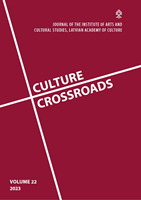ABDUCTIVE REASONING AS A MODEL FOR MUSICAL CREATION IN JULIO ESTRADA’S MUSICAL WORKS
ABDUCTIVE REASONING AS A MODEL FOR MUSICAL CREATION IN JULIO ESTRADA’S MUSICAL WORKS
Author(s): Manuel Domínguez SalasSubject(s): Music, Aesthetics, Sociology of Art, History of Art
Published by: Latvijas Kultūras akadēmija
Keywords: abductive reasoning; scientific discovery; macro timbre; chronography;
Summary/Abstract: The paper deals with two philosophical postulates that although at first sight both do not have a direct link, it is my hypothesis that there may be a connection between them since in each one imagination plays an important role in the process of scientific discovery. On the one hand, it deals with the abductive reasoning by Charles Sanders Pierce (1839–1914), focusing on the problem related with abduction and scientific imagination, graphicacy or the ability to represent ideas through images, beelddenken or “pictorial thinking” as a form of communicating ideas without the use of any verbal form, and synthetic topology responsible for studying the qualitative relations of any 3-D geometrical structure. On the other hand, the author presents the philosophical postulates of the Theory of Composition: discontinuum-continuum by Julio Estrada (*1941), where reality and imagination play an important role in the process of musical creation, presenting a two-fold methodology of creation, (1) the macro timbre where the homogenization of the components of the rhythmsound takes place, and (2) the chronography, a graphic representation of the rhythmsound in movement. The latter is exemplified in this paper with the three examples of Estrada’s musical compositions, (1) the graphical score of eua’on UPIC (1980), (2) graphical recording for the series yuunohui’ (1983–2020), and (3) the topological variations included in the ishini’ioni String Quartet (1984–1990).
Journal: Culture Crossroads
- Issue Year: 22/2023
- Issue No: 1
- Page Range: 88-104
- Page Count: 17
- Language: English

